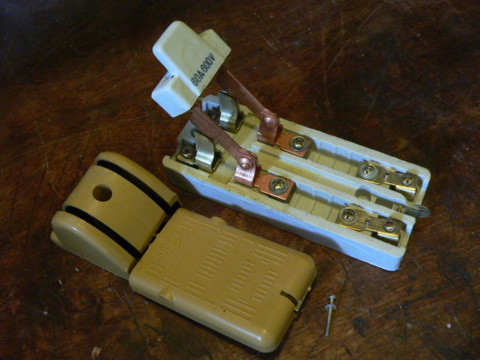
|

|
Forum Index : Electronics : Kill Switch
| Author | Message | ||||
| piercy007 Newbie Joined: 27/06/2008 Location: United KingdomPosts: 28 |
Evening all Just a quick question (I think) - how does a Kill Switch work? I am right in thinking it justs shorts out the power supply from a Wind Genny? If so were do you mount the break before the battery or between battery and load? 
I have done some googling and got loads of referances to kill switches but no diagram or description of what one looks like or acts. 
I was thinking it was just a switch that is on and sits between the AC in and rectifier. You then flick it to off to "kill" it. Is that too simple? 
My middle name is luck mind you my first is bad! |
||||
CraziestOzzy Senior Member Joined: 11/07/2008 Location: AustraliaPosts: 135 |
To help you, is this "switch" to be automatic or manual and what is it safe guarding against (current? voltage? RPM?) cheers and have a look at Wiki http://cr4.globalspec.com/member?u=25757 http://www.instructables.com/member/OzzyRoo/ |
||||
| piercy007 Newbie Joined: 27/06/2008 Location: United KingdomPosts: 28 |
I was thinking simple so a manual one. Current and Voltage i.e. protect the batteries and any loads on them My middle name is luck mind you my first is bad! |
||||
CraziestOzzy Senior Member Joined: 11/07/2008 Location: AustraliaPosts: 135 |
Wiki has a nice reference to Circuit breakers that are automatic and can be manual too. IF you kill the supply to your batteries generated by your wind generator, you will need to redirect the juice (voltage and current) to a dump (shunt). A good relay suited to your working application will redirect the flow of voltage/current when you or conditions cause the "circuit breaker" to "kill" the supply to the batteries. I would place the "kill switch" just before your batteries input if you are protecting your batteries, but make room for some arc protection during the breaking of your contact and switching load to a shunt to protect your relay from quick wear tear. I would bet there are probably some schematics in this forum somewhere with details on what you seek. The sky is the limit as to where else you may apply sensors that will activate the relay to redirect your wind generator output to dump load outside of the general "circuit breaker" I mention. These are just my thoughts on the matter over a coffee. Hope it helps http://cr4.globalspec.com/member?u=25757 http://www.instructables.com/member/OzzyRoo/ |
||||
oztules Guru Joined: 26/07/2007 Location: AustraliaPosts: 1686 |
Piercy007 The "Kill switch" your referring to in windmill parlance is used to short out the AC side of the rectifiers. This comes with several good and bad features. The idea is that (for a Permanent magnet genny), if we short out the output, then the load presented to the blades will hopefully be enough to stall the blades and stop the rotation of the mill. Depending on the alternator impedance, this does not always work they we wished. The other day when Jamies AWP windmill http://www.thebackshed.com/Windmill/FORUM1/forum_posts.asp?T ID=1165&PN=1 lost a phase, we needed to pull it down to fix it. We tried the kill switch but in the high winds, the braking torque provided by the remaining two phases was not enough to "brake" the mill sufficiently to get it into stall. This mill is High Voltage (200-500v and more) and so has a high impedance (20 or more ohms per phase). Even when all phases are good, you need a lull in the strong winds to drag it into stall with the kill switch. My alternator on the other hand is only .8 of an ohm, and when you short it out it nearly jumps into next week, so it needs a gradual short (first one phase to take some speed off then the rest). So the "stiffness" of the alternator will dictate in what winds it will "brake" sucessfully. It is always good to try and find a lull in the wind before pulling it on or you overload the coils for too long before it comes under control. The coils and the wiring will be soaking up all the power until it comes under control, and we don't want that to be a long time or damage may result. Once the kill switch has stopped the mill, it will keep it stopped in pretty strong winds, it will slowly turn but stay in stall. Even the AWP which has a lot of blade and good root dynamics can hold it in stall once slowed down enough, even with a very high impedance and feeble magnets. We put the switch across the phases before the rectifier to guard against shorting the battery bank (not good). (the windmill side of the rectifier NOT the battery side of the rectifier) We can use a two pole single throw if we use the third phase to short out the two floating terminals. The live terminals will be isolated, but on throwing the switch, will join all three phases together, braking the mill. We can use three pole if we want also. ( switch all phases together through three sets of contacts instead of 2 if it is easier to visualise) Depending on the output, and when you intend to short it will dictate how big a switch you will need. The nice thing about shorting the AC side, is that we have far less arcing than if we isolated the batteries and tried then to short the DC side, putting the rectifiers under excessive load, and allowing the mill to runaway while we disconnected the batteries..... all bad. This could be done with a double throw triple pole switch....but don't do it this way. Use the mill (AC) side and avoid all this. The rectifiers will isolate this ac shorting from the batteries, so the batteries won't see what we are doing. A lot of people seem to be using those old horror movie Knife Switches, big and open design, and look good too. like this one from Otherpower.com: 
http://www.forcefieldmagnets.com/catalog/product_info.php?cP ath=24&products_id=194 Here you would use one phase to both terminals on one end of the switch, and the other two phases to each of the two terminals at the other end. When the switch closes it shorts all three phases together, braking the mill. (wind permitting) But remember, it must be installed between the windmill and the rectifier or molten metal will go everywhere it you try this across the batteries. If you only want to protect against overcharging, then a dump load would be the answer. Although in theory, you could "kill" every time you reach fully charged, it is not generally done as it introduces stresses on the mill it doesn't need, and is not very delicate or reliable. In a big wind it may not stop it without supervision. And thats how it works in the systems I have worked with ........oztules Village idiot...or... just another hack out of his depth |
||||
Gill Senior Member Joined: 11/11/2006 Location: AustraliaPosts: 669 |
Well put oz', an informative read. was working fine... til the smoke got out. Cheers Gill _Cairns, FNQ |
||||